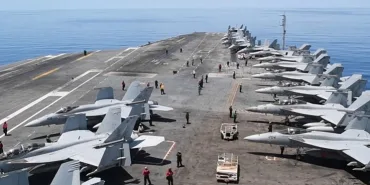Lockheed Martin’s F-35 programme has reached 20 countries with more than 1,200 deliveries. However, the US’s strict export restrictions and technology control have sparked strategic debates about the aircraft’s global reach.
The Lockheed Martin F-35 Lightning II, widely regarded as the world’s most popular fighter jet, is redefining global standards in fifth-generation combat aircraft. To date, the F-35 programme has delivered more than 1,200 jets and received over 3,000 orders from 20 countries.
This figure surpasses the combined production numbers of all other fifth-generation fighter aircraft (F-22, Su-57, J-20, and J-35). Despite the US’s stringent export conditions, the F-35’s appeal continues to grow year after year.
The United States maintains tight control over the aircraft’s source code, maintenance, spare parts supply, and operational conditions. For instance, Turkey was removed from the F-35 programme in 2018 after deciding to purchase the Russian S-400 air defence system. The US also prohibits F-35s from participating in exercises held in countries operating the S-400 system and bans dual-national Israeli pilots from flying the jet.
Multinational Development Programme
Contrary to popular belief, the F-35 is not solely an American project; it is a joint development initiative funded by eight countries.
Known as the Joint Strike Fighter (JSF) programme, the F-35 initiative stands out as one of the most extensive international defence industry collaborations in history.
According to Lockheed Martin, between 30% and 42% of the jet is produced outside the United States, spanning three different continents.
Founding partners and their investment tiers are as follows:
- Tier 1: United Kingdom (USD 2.5 billion investment)
- Tier 2: Italy (USD 1 billion) and the Netherlands (USD 800 million)
- Tier 3: Australia, Canada, Denmark, Norway, and Turkey
Turkey was a significant production partner in the programme but was removed in 2019 under US sanctions.
Global Supply Chain: 42,000 Hours of Production Over 18 Months
Each F-35 takes approximately 18 months or 42,000 labour hours to complete.
Starting the assembly line with only a single wing, each jet is completed through a complex global supply chain spanning dozens of countries.
The United Kingdom, as the only Tier 1 partner in the F-35 programme, produces about 15% of the aircraft’s components.
BAE Systems provides the rear fuselage, tail assembly, electronic warfare systems, and avionics components, while Martin Baker supplies the ejection seats and Rolls-Royce produces the LiftSystem that enables vertical take-off capability.
Italy’s Leonardo manufactures electro-optical systems, engine components, and radio subsystems, and hosts the European final assembly and check-out facility in Cameri.
The Netherlands’ GKN Fokker is responsible for radar systems, landing gear doors, and drag chute systems.
Australia supplies the vertical tail and actuator systems, while Canada contributes composite panels, folding wings, and LED simulator screens.
Norway provides air-to-air pylons, Germany’s Rheinmetall manufactures fuselage parts, Japan operates its own assembly line, and Israel supplies outer wings, electronic warfare systems, and fuel tanks.
US Control and Technology Protection
Despite the global cooperation, the US Department of Defense and Lockheed Martin strictly safeguard the F-35’s intellectual property rights, source code, and logistics software.
The Autonomic Logistics Information System (ALIS), used for the jet’s maintenance and operational processes, operates under US control.
This ensures Washington maintains full authority over the F-35 while limiting the operational independence of allied nations.
F-35: A Symbol of Global Air Superiority
With its stealth capabilities, multi-role functionality, and network-centric warfare technologies, the F-35 forms the backbone of modern air forces.
In service not only with the US but also with countries such as the UK, Japan, Norway, South Korea, and Australia, the aircraft continues to shape the future of air superiority concepts.

Aero Haber X-Twitter you can follow his account. Follow









